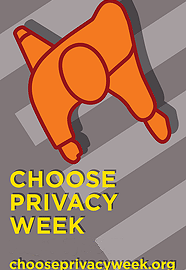This post is Part 1 in a two-part series highlighting our team members’ work with Choose Privacy Week. This initiative of the American Library Association puts a spotlight on issues of privacy in today’s digital world, such as tracking in online searches. Knowing how your data are used is a component of data literacy, and we are excited to feature our team members’ blog posts on these topics.
Connie wrote about the traces that online actions leave and how they affect teens on the Choose Privacy Week blog. Here is an excerpt from her piece:
…there are universal norms that our students must know about their online presence: what you post can describe you, once a post leaves your device it is no longer in your control, and there is indeed, a digital footprint that gets left behind.
What this means for children and teens is that their online lives can follow them through their offline lives. If they post provocative things or mean things or negative things, they will be perceived by their online friends as those things; even if they are none of those things in their offline lives. One of the hardest ideas for teens to grasp sometimes is the idea that they are often creating a ‘body of work’ that can define them to others.
Online work can certainly have broad implications. Being active online, and managing privacy at the same time, are not always easy, though. Connie suggests establishing norms:
…it is important that we begin thinking about how we will allow our growing children online access while still keeping them protected. While online security is not a typical survival necessity, it is one that can impact our children. As adults, the information we share about our children with our own friends and families is the first step to modeling positive online behavior. Setting up norms that children learn to follow and understand – ‘hand holding’ – will allow parents and educators to loosen that grip, enabling them to expand their access as they grow and demonstrate their abilities to participate positively.
Instruction on best practices for students can take a variety of forms, and Connie goes on to provide examples. Thanks, Connie!
Image: “Choose Privacy Week 2013,” American Library Association, on Choose Privacy Week
